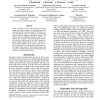Free Online Productivity Tools
i2Speak
i2Symbol
i2OCR
iTex2Img
iWeb2Print
iWeb2Shot
i2Type
iPdf2Split
iPdf2Merge
i2Bopomofo
i2Arabic
i2Style
i2Image
i2PDF
iLatex2Rtf
Sci2ools
AAAI
2006
2006
The Power of Sequential Single-Item Auctions for Agent Coordination
Teams of robots are more fault tolerant than single robots, and auctions appear to be promising means for coordinating them. In a recent paper at "Robotics: Science and Systems 2005," we analyzed a coordination system based on sequential single-item auctions. We showed that the coordination system is simple to implement and computation and communication efficient, and that the resulting sum of all travel distances in known terrain is guaranteed to be only a constant factor away from optimum. In this paper, we put these results in perspective by comparing our coordination system against those based on either parallel single-item auctions or combinatorial auctions, demonstrating that it combines the advantages of both.
AAAI 2006 | Fault Tolerant | Intelligent Agents | Sequential Single-item Auctions | Single-item Auctions |
| Added | 30 Oct 2010 |
| Updated | 30 Oct 2010 |
| Type | Conference |
| Year | 2006 |
| Where | AAAI |
| Authors | Sven Koenig, Craig A. Tovey, Michail G. Lagoudakis, Evangelos Markakis, David Kempe, Pinar Keskinocak, Anton J. Kleywegt, Adam Meyerson, Sonal Jain |
Comments (0)

